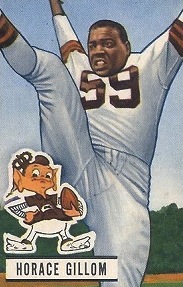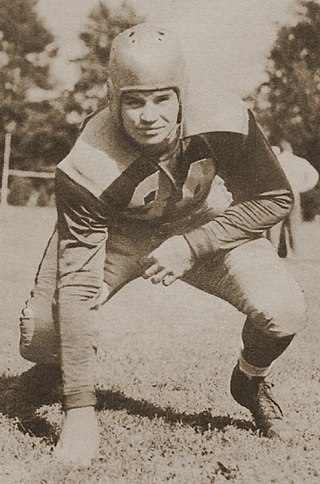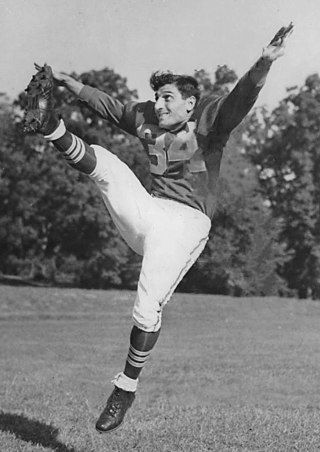
Leonard Guy Ford Jr. was an American professional football player who was an offensive and defensive end from 1948 to 1958. He played college football for the University of Michigan and professional football for the Los Angeles Dons, Cleveland Browns and Green Bay Packers. He was inducted into the Pro Football Hall of Fame in 1976 and the University of Michigan Athletic Hall of Honor in 1996.

Louis Roy Groza, nicknamed "the Toe", was an American professional football offensive tackle and placekicker while playing his entire career for the Cleveland Browns in the All-America Football Conference (AAFC) and National Football League (NFL). Groza was professional football's career kicking and points leader when he retired after the 1967 season. He played in 21 seasons for the Browns, helping the team to win eight league championships in that span. Groza's accuracy and strength as a kicker influenced the development of place-kicking as a specialty; he could kick field goals from beyond 50 yards (46 m) at a time when attempts from that distance were a rarity. He set numerous records for distance and number of field goals kicked during his career.

Dante Bert Joseph Lavelli, nicknamed "Gluefingers", was an American professional football end who played for the Cleveland Browns in the All-America Football Conference (AAFC) and the National Football League (NFL) from 1946 to 1956. Starring alongside quarterback Otto Graham, fullback Marion Motley, kicker Lou Groza and fellow receiver Mac Speedie, Lavelli was an integral part of a Browns team that won seven championships during his 11-season career. Lavelli was known for his sure hands and improvisations on the field. He was also renowned for making catches in critical situations, earning the nickname "Mr. Clutch". Browns head coach Paul Brown once said of him: "Lavelli had one of the strongest pairs of hands I've ever seen, when he went up for a pass with a defender, you could almost always count on him coming back down with the ball."

Anthony Adamle was an American professional football player who was a linebacker and fullback in the All-America Football Conference (AAFC) and the National Football League (NFL). He played his entire career for the Cleveland Browns before retiring to pursue a medical degree.

Mac Curtis Speedie was an American professional football end who played for the Cleveland Browns in the All-America Football Conference (AAFC) and the National Football League (NFL) for seven years before joining the Saskatchewan Roughriders in Canada. He later served for two years as head coach of the American Football League's Denver Broncos. A tall and quick runner whose awkward gait helped him deceive defenders and get open, Speedie led his league in receptions four times during his career and was selected as a first-team All-Pro six times. His career average of 800 yards per season was not surpassed until two decades after his retirement, and his per-game average of 50 yards went unequalled for 20 years after he left the game.

Louis Joseph "the Battler" Rymkus was an American football player and coach in the All-America Football Conference (AAFC), National Football League (NFL) and American Football League (AFL). Playing as a tackle for the Cleveland Browns in the AAFC and NFL in the late 1940s and early 1950s, Rymkus provided pass protection for quarterback Otto Graham as the team won five league championships. Following his playing career, Rymkus took a number of assistant coaching jobs before serving as the first head coach of the AFL's Houston Oilers in 1960. The team won the league's first championship, but Rymkus was fired by Oilers owner Bud Adams after a slow start in 1961.

Thomas Laverne James, Jr. was an American football defensive back and punter who played for Ohio State University and the Cleveland Browns in the 1940s and 1950s. He was born in Canton, Ohio and attended Massillon Washington High School, where he played as a back on the football team under head coach Paul Brown. James was a key part of a Massillon team that went undefeated in 1940. After graduating, he followed Brown to Ohio State and played there as a halfback. Ohio State won its first national championship in 1942 when James was on the team.
The 1946 Cleveland Browns season was the team's first in the All-America Football Conference (AAFC). The Browns, coached by Paul Brown, ended the year with a record of 12–2, winning the AAFC's Western Division. Led by quarterback Otto Graham, fullback Marion Motley and ends Dante Lavelli and Mac Speedie, the team won the first AAFC championship game against the New York Yankees.
The 1947 Cleveland Browns season was the team's second in the All-America Football Conference (AAFC). Led by head coach Paul Brown, Cleveland finished with a 12–1–1 record, winning the Western division and the AAFC championship for the second straight year. As in 1946, quarterback Otto Graham led an offensive attack that featured fullback Marion Motley, ends Dante Lavelli, and Mac Speedie.
The 1948 Cleveland Browns season was the team's third in the All-America Football Conference (AAFC). After winning the AAFC crown in 1946 and 1947, the league's first two years of existence, the Browns repeated as champions in 1948 and had a perfect season, winning all of their games.
The 1949 Cleveland Browns season was the team's fourth and final season in the All-America Football Conference (AAFC). The Browns finished the regular season with a 9–1–2 win–loss–tie record and beat the San Francisco 49ers to win their fourth straight league championship. In the season's sixth game on October 9, the 49ers stopped the Browns' professional football record unbeaten streak at 29 games. It began two years earlier on October 19, 1947, and included two league championship games and two ties.
The 1950 Cleveland Browns season was the team's first in the National Football League (NFL) after playing the previous four years in the All-America Football Conference (AAFC), which folded after the 1949 season. The Browns finished the regular season with a 10–2 win–loss record and beat the Los Angeles Rams to win the NFL championship. It was Cleveland's fifth consecutive championship victory, the previous four having come in the AAFC.

Warren Emmett Lahr was an American professional football player who was a defensive back who played for the Cleveland Browns for 11 seasons, mainly in the 1950s. When he retired, he had the most career interceptions in Browns team history with 44.

Horace Albert "Big Horse" Gillom was an American professional football player who was a punter and end in the All-America Football Conference (AAFC) and National Football League (NFL). He played ten seasons for the Cleveland Browns between 1947 and 1956. Cleveland head coach Paul Brown, who coached Gillom in high school, college and professionally, called him his best all-around high school player and once said there "has never been a better punter than Horace".

Chester Frank Adams was a professional American football tackle and placekicker who played ten seasons in the National Football League (NFL) and All-America Football Conference (AAFC), mainly with the Cleveland Rams and Cleveland Browns. He was selected to the NFL's All-Star game twice. In 1978, he was inducted into the Greater Cleveland Sports Hall of Fame.

Thomas Anthony Colella was an American professional football halfback, punter and safety who played in the National Football League (NFL) and All-America Football Conference (AAFC) for the Detroit Lions, the Cleveland Rams, the Cleveland Browns and the Buffalo Bills.

Rex Keith Bumgardner was a halfback in the All-America Football Conference (AAFC) and National Football League (NFL) for the Buffalo Bills and the Cleveland Browns in the late 1940s and early 1950s.

Robert George Cowan was an American football halfback who played three seasons in the All-America Football Conference (AAFC) between 1947 and 1949. Cowan played for the Cleveland Browns and the Baltimore Colts.

Angelo Robert Gaudio was an American football guard who played four seasons for the Cleveland Browns in the All-America Football Conference (AAFC) and National Football League (NFL) between 1947 and 1951.
Edward J. "Foozy" Sustersic was an American football fullback and linebacker who played one season in the All-America Football Conference (AAFC) for the Cleveland Browns.














